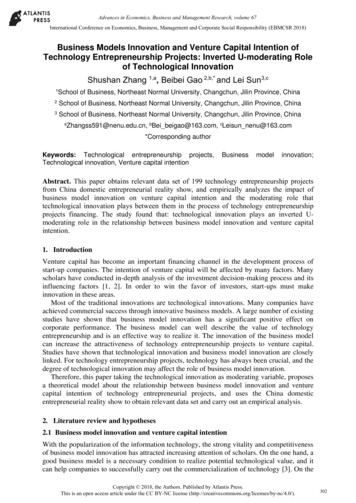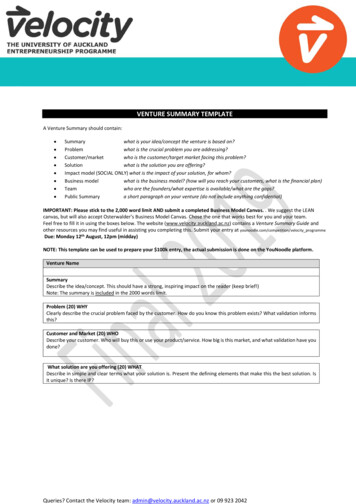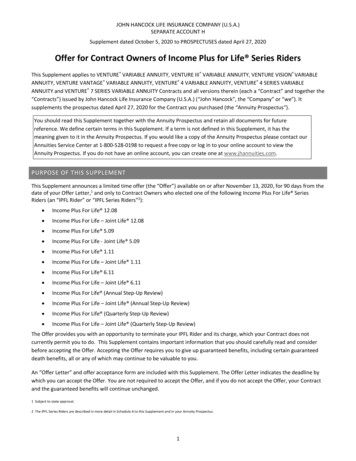
Transcription
Advances in Economics, Business and Management Research, volume 67International Conference on Economics, Business, Management and Corporate Social Responsibility (EBMCSR 2018)Business Models Innovation and Venture Capital Intention ofTechnology Entrepreneurship Projects: Inverted U-moderating Roleof Technological InnovationShushan Zhang 1,a, Beibei Gao 2,b,* and Lei Sun3,c1Schoolof Business, Northeast Normal University, Changchun, Jilin Province, China2School of Business, Northeast Normal University, Changchun, Jilin Province, China3School of Business, Northeast Normal University, Changchun, Jilin Province, ChinaaZhangss591@nenu.edu.cn, bBei beigao@163.com, cLeisun nenu@163.com*Corresponding authorKeywords: Technological entrepreneurship projects,Technological innovation, Venture capital intentionBusinessmodelinnovation;Abstract. This paper obtains relevant data set of 199 technology entrepreneurship projectsfrom China domestic entrepreneurial reality show, and empirically analyzes the impact ofbusiness model innovation on venture capital intention and the moderating role thattechnological innovation plays between them in the process of technology entrepreneurshipprojects financing. The study found that: technological innovation plays an inverted Umoderating role in the relationship between business model innovation and venture capitalintention.1. IntroductionVenture capital has become an important financing channel in the development process ofstart-up companies. The intention of venture capital will be affected by many factors. Manyscholars have conducted in-depth analysis of the investment decision-making process and itsinfluencing factors [1, 2]. In order to win the favor of investors, start-ups must makeinnovation in these areas.Most of the traditional innovations are technological innovations. Many companies haveachieved commercial success through innovative business models. A large number of existingstudies have shown that business model innovation has a significant positive effect oncorporate performance. The business model can well describe the value of technologyentrepreneurship and is an effective way to realize it. The innovation of the business modelcan increase the attractiveness of technology entrepreneurship projects to venture capital.Studies have shown that technological innovation and business model innovation are closelylinked. For technology entrepreneurship projects, technology has always been crucial, and thedegree of technological innovation may affect the role of business model innovation.Therefore, this paper taking the technological innovation as moderating variable, proposesa theoretical model about the relationship between business model innovation and venturecapital intention of technology entrepreneurial projects, and uses the China domesticentrepreneurial reality show to obtain relevant data set and carry out an empirical analysis.2. Literature review and hypotheses2.1 Business model innovation and venture capital intentionWith the popularization of the information technology, the strong vitality and competitivenessof business model innovation has attracted increasing attention of scholars. On the one hand, agood business model is a necessary condition to realize potential technological value, and itcan help companies to successfully carry out the commercialization of technology [3]. On theCopyright 2018, the Authors. Published by Atlantis Press.This is an open access article under the CC BY-NC license 02
Advances in Economics, Business and Management Research, volume 67other hand, technological entrepreneurship is technology and knowledge-intensive. Hence it’soften difficult to understand for stakeholders such as investors and customers. Business modelcan give a comprehensive explanation for this complex process and expound its value to maketechnology entrepreneurship easier to understand, increasing the legitimacy and reliability ofinnovation, and reducing uncertainty [4, 5]. Business model innovation is conducive forstart-up companies to demonstrate their legal status and obtain the recognition of stakeholders[6]. Xu and Dan proposed a venture capital decision model which includes three dimensions:the quality and ability of entrepreneurs [7], the business model of project, and the conditionsof start-up companies. Therefore, we hypothesize:H1: Business model innovation has a positive effect on venture capital intention intechnology entrepreneurship projects2.2 The moderating role of technological innovationMost of the existing studies have shown that the strengthening of technological innovationshould be linear, which means the higher the degree of technological innovation, the strongerthe impact of business model innovation on venture capital intention. However, the dependentvariables of previous studies are mostly corporate performance and that of this study is theinvestment intention of venture capital. The willingness of investors to participate in thestartups’ management will also affect their investment intention. After investing in start-upcompanies, venture capital can participate in its subsequent strategic and operational activitiesand be the designer of business model [8]. When the level of technological innovation is high,investors will focus more on technology and have higher willingness to participate inmanagement. They are willing to use their relevant resources and experience to build arational and efficient business model for startups, which can make up for the lack of startups’business model. Therefore, this study believes that technological innovation has a non-linearrole in regulating the relationship of business model innovation and venture capital intention.Within a certain range, the moderating role of technological innovation increases as theincrease of innovation degree. When technological innovation reaches a higher point, theimportance of business model innovation is relatively reduced and its impact on venturecapital intention is weaken, that is, as the degree of technological innovation increases, thepositive impact of business model innovation on venture capital intention increases first andthen weakens. Therefore, we hypothesize:H2: Technological innovation has an inverted U-shaped moderating role between businessmodel innovation and venture capital intention.3. Study design3.1 Data collection and measuresThe empirical data set of this research comes from the entrepreneurial reality show- “TheEntrepreneurship Elites” broadcast by CCTV. We selects 108 programs from January 2016 toMarch 2018, a total of 321 entrepreneurial projects. Finally, 199 projects were obtained.In this study, technological innovation and business model innovation are measured by5-point Likert scale. After the full argument and analysis of the research team, three teammembers respectively scored each variable of each entrepreneurial project according to thevideo and related data. The measurement of technological innovation mainly refers to theresearch of Yang and Hou [9, 10] on technical evaluation and technical innovation. Themeasurement of business model innovation adopted the scales employed by Zottc and Amit,Pang et al, and Guo et al [11, 12, 13]. This study uses the investors’ investment intention onentrepreneurial projects to measure the venture capital intention.303
Advances in Economics, Business and Management Research, volume 673.2 Reliability and validityThe reliability and validity of the measurement tools are evaluated. The Cronbach’s αcoefficients of business model innovation and technical innovation are 0.904 and 0.894,indicating that the two scales both have good reliability. The factor load of business modelinnovation is in a range of 0.75-0.93 (χ2/df 0.785; RMSEA 0.000; CFI 1.000; NFI 0.997)and that of technological innovation is in a range of 0.76-0.91 (χ2/df 2.141; RMSEA 0.076;CFI 0.995; NFI 0.991). All fit indicators reached acceptable levels. And the AVE values ofall scales were greater than 0.5 (business model innovation 0.715; technological innovation0.692), indicating that the scales have good convergence validity.4. Regression analysis resultsEach hypothesis was verified by constructing a regression model. The results are shown inTable 1. In Table 1, the dependent variable is venture capital intention. Model 1 only adds thecontrol variables. Model 2 adds the business model innovation on the basis of the controlvariables, and model 3 adds the technological innovation and the first-order interaction oftechnology innovation and business model innovation on the basis of model 2. Model 4 addsthe second-order interaction of technological innovation and business model innovation onthe basis of Model 3. The variance inflation factors (VIF) in all models are less than 10, sothere is no serious multicollinearity problem among the independent variables.Test the inverted U-moderating role of technological innovation. From model 4, we cansee that after adding the second-order interaction of technological innovation and businessmodel innovation, the model's R2 has increased to 0.447, and the overall explanatory abilityhas been improved. The impact of business model innovation on venture capital intentionremains significant (β 0.085, P 0.001). The first-order interaction is positive significant(β 0.276, P 0.01), and the second-order interaction is negative significant (β -0.276, P 0.01),indicating technological innovation has an inverted U-shaped moderating role betweenbusiness model innovation and venture capital intention. See Fig.1 for details. The positiveimpact of business model innovation on venture capital intention increases first and thenweakens as technology innovation increases. Therefore, H2 is supported.Table 1 Regression analysis resultsModel preneur'sgenderEntrepreneur's Project valuationTI * BMISecond-orderinteractionTI 2 * BMIModel **0.096***0.0060.276**Business st-orderinteractionVenture capital intentionModel 2Model 3R20.109Adjust R20.086F4.734***Note: * P 0.05; **P 0.01; ***P **0.4470.42116.966***304
Advances in Economics, Business and Management Research, volume 67Fig. 1 The moderating role of technological innovation5. Discussion and conclusionsThis paper constructs a theoretical model that business model innovation influences theventure capital intention, taking technological innovation as a moderating variable, andconducts an empirical test on the data of technology entrepreneurship projects collectedthrough the entrepreneurial reality show. The research content has important theoreticalsignificance and practical value.There are two limitations of this study are as follows: The projects data are not fullydisplayed; The independent variable and moderating variable are measured in a certainpersonal preferences. In future research, we can track the entrepreneurial projects and carryout other related researches in depth on the basis of this study.AcknowledgementThis research was financially supported by the National Social Science Foundation of China(Grant NO. 18BJY180).References[1] T. T. Tyebjee, A. V. Bruno, A model of Venture Capitalist Investment Activity,Management Science, Vol. 9, pp. 1051-1066, 1984.[2] J. Su, High-Tech Enterprise Risk Investment Evaluation Study, Science & TechnologyProgress and Policy, Vol. 30, pp. 124-127, 2013.[3] M. Cucculelli, C. Bettinelli, Business models, intangibles and firm performance: evidenceon corporate entrepreneurship from Italian manufacturing SMEs, Small BusinessEconomics, Vol. 45, pp. 329-350, 2015.[4] L. Doganova, R. M. Eyquem, What do business models do? Innovation devices intechnology entrepreneurship, Research Policy, Vol. 38, pp. 1559-1570, 2009.[5] M. Lounsbury, M. A. Glynn, Cultural entrepreneurship: stories, legitimacy and theacquisition of resources, Strategic Management Journal, Vol. 22, pp. 45–56, 2001.[6] Y. Z. Du, Y. L. Zhang, and B. Ren, Showing or Hiding Competitive Advantage: TheU-shaped Relationship of New Firm Competitor Orientation and Performance and theMediating Role of Organization Legitimacy. Management World, Vol. 7, pp. 96-107,2012.[7] X. S. Xu, Z. Y. Dan, Fuzzy Comprehensive Evaluation Model for Investment Risk ofHigh-tech Projects, Quantitative & Technical Economics, Vol. 1, pp. 23-25, 2000.305
Advances in Economics, Business and Management Research, volume 67[8] Y. N. Gou, J. Dong, Influence of venture capital background on firms’ technologicalinnovation, Science Research Management, Vol. 35, pp. 35-42, 2014.[9] Q. Yang, Y. Li, and L. S. Yin, Compositive Assessment Model of Venture Enterprises’Investment Value Based on Grey Theory, Journal of Wuhan University of Technology, Vol.4, pp. 495-498, 2005.[10] T. Hou, D. H. Zhu, SWOT analysis based innovation project technology assessment anddecision research, Science Research Management, Vol. 4, pp. 1-6, 2006.[11] C. Zottc, R. H. Amit, Designing Your Future Business Model:an Activity SystemPerspective, Long Range Planning, Vol. 43, pp. 216-226, 2010.[12] C. W. Pang, Y. Li, and G. Duan, Integrative Capability and Firm Performance: TheMediating Effect of Business Model Innovation, Journal of Management Science, Vol. 28,pp. 31-41, 2015.[13] T. Guo, Y. Wu, and H. D. Liu, The Study of the effect of entrepreneurs’ backgroundcharacteristics on the performance of technology startups: The mediating role of businessmodel innovation, Science and Technology Progress and Policy, Vol. 34, pp. 86- 91,2017.306
investment intention of venture capital. The willingness of investors to participate in the startups' management will also affect their investment intention. After investing in start-up companies, venture capital can participate in its subsequent strategic and operational activities and be the designer of business model [8].










